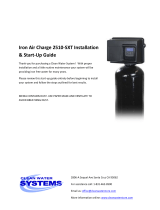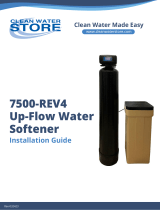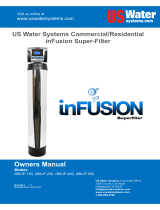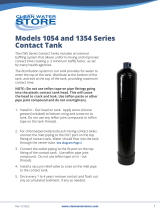
7500-M Sediment Filter Installation Guide
Thank you for purchasing a Clean Water System! With proper installation and a
little routine maintenance your system will be providing Sediment free water for
many years.
Please review this start‐up guide entirely before beginning to install your system,
and follow the steps outlined for best results.
Minimum pressure of 30 PSI recommended.
Maximum pressure recommended 80 PSI.
For indoor installation only.
Protect from sunlight, rain, and freezing.
SEDIMENT MEDIA CONTAINS DUST.
USE MASK TO AVOID BREATHING DUST.
OK to wet down media with spray bottle
Questions?
Call us toll‐free: 1‐888‐600‐5426 or 1‐831‐462‐8500
Email us: support@cleanwaterstore.com
See more information on our website: www.cleanwaterstore.com/resources
Clean Water Made Easy
www.cleanwaterstore.com

Table of Contents
Packing Lists .................................................................................................................................................. 3
Pre‐Installation .............................................................................................................................................. 4
Best Practices for Piping & Drain Installation: .............................................................................................. 4
Installation of Your System in Copper or Metal Piping Systems: .................................................................. 5
How Your Sediment Filter Works: ................................................................................................................. 6
Assembly and Installation Instructions: ........................................................................................................ 7
Programming Your Valve and Setting Time and Days for Backwash ............................................................ 8
Initial Backwash .......................................................................................................................................... 10
Maintenance: .............................................................................................................................................. 11
Troubleshooting the 7500‐M Sediment Filter: ........................................................................................... 11

7500-M Sediment Filter Installation & Startup Guide
3 www.cleanwaterstore.com 042021
Packing Lists
All systems include:
7500‐M control valve, 3 female NPT to BSP black pipe adapters, power supply, funnel for
adding media, start‐up guide, and items included in one of the following options:
Find Your Size System to See What is Included:
What to Do if Your Tank is Not Level Out of the Box:
Your black filter tank base is not glued to the bottom of your tank. Occasionally tank bases will become
crooked during shipment. If you find that that your tank does not sit level on the floor, you can easily
adjust it by holding the empty tank and knocking it on a concrete or solid floor once or twice to level it.
Sediment Filter 0.75 cubic foot size
8” x 44” filter tank with distributor tube
8 lbs. filter gravel
0.75 cubic foot of Sediment Media
Sediment Filter 1.0 cubic foot size
9” x 48” filter tank with distributor tube
12 lbs. filter gravel
1 cubic foot of Sediment Media
Sediment Filter 1.5 cubic foot size
10” x 54” filter tank with distributor tube
16 lbs. Filter gravel
1.5 cubic foot of Sediment Media
Sediment Filter 2.0 cubic foot size
12” x 52” filter tank with distributor tube
20 lbs. filter gravel
2.0 cubic foot of Sediment Media
Sediment Filter 2.5 cubic foot size
13” x 54” filter tank with distributor tube
35 lbs. filter gravel
2.5 cubic foot of Sediment Media
Sediment Filter 3.0 cubic foot size
14” x 65” filter tank with distributor tube
40 lbs. filter gravel
3.0 cubic foot of Sediment Media

7500-M Sediment Filter Installation & Startup Guide
4 www.cleanwaterstore.com 042021
Pre-Installation
1. Review your packing list and make sure you have received all the parts before installation.
2. If you are going to be turning off the water to the house and you have an electric water heater,
shut off the power to the water heater before beginning installation in case water heater is
accidentally drained.
3. Pick a suitable location for your filter system on a dry level spot where it won’t be exposed to
freezing temperatures. A minimum of 30 PSI is required. Maximum pressure is 90 PSI.
4. Get all of your plumbing parts together before beginning installation, and make sure you have
received all of your packages before beginning or scheduling an installation. Installation typically
takes 3 to 5 hours. However, after installation the Sediment Filter must be allowed to run
through a complete backwash and rinse cycle.
5. After the system is installed and running, your water may be discolored, or full of sediment or
rust, particularly if this is older or corroded piping. This typically clears up over a day or two.
Best Practices for Piping & Drain Installation:
1. Make sure to connect the Inlet from your water source and outlet, following arrows on control
valve. Connect the External Flow Control fitting onto the Drain
line. You must use the 3 female pipe adapters provided.
Assemble all fittings into valve fitting prior to installion to the
head. These seal with the blue seals and if overtightened can
damage the valve body.
2. Make sure there is a working gate or ball valve before the 7500
Filter System and also one after as well as a bypass valve. A hose
bib (which is a faucet to which you can attach a garden hose) is
strongly recommended after the Sediment Filter and before the
second ball valve. This makes it easy to rinse your new Sediment
Filter on start‐up and gives you a place to test the water.
3. If you will be using copper piping, do not sweat the copper pipe
directly on to the 7500‐M control valve.
4. You should install unions and a bypass around the valve, so that you can remove it and still have
water (See Build Your Bypass).
5. To connect drain line to drain, use an air‐gap connection, so that if your sewer or septic tank
backs up, it cannot cross connect with the drain tubing.

7500-M Sediment Filter Installation & Startup Guide
5 www.cleanwaterstore.com 042021
Installation of Your System in Copper or Metal Piping Systems:
If your new filter system is to be installed in a metal (conductive) plumbing system, i.e. copper or
galvanized steel pipe, the plastic components of the system will interrupt the electrical continuity of the
plumbing system.
As a result, any stray currents from improperly grounded appliances downstream or potential galvanic
activity in the plumbing system can no longer ground through the contiguous metal plumbing.
Some homes may have been built in accordance with building codes, which encouraged the grounding
of electrical appliances through the plumbing system.
Consequently, the installation of a bypass consisting of the same material as the existing plumbing, or a
grounded "jumper wire" bridging the equipment and reestablishing the contiguous conductive nature of
the plumbing system must be installed prior to your systems use.
This is simple and easy step to take if you are installing your water treatment system into copper
piping. A simple ground jumper wire with a pipe clamp can be purchased at any Home Center, or
hardware store etc. for a few dollars.

7500-M Sediment Filter Installation & Startup Guide
6 www.cleanwaterstore.com 042021
How Your Sediment Filter Works:
Water enters the top of the tank and
flows down through the media and up
the distributor tube.
The backwashing Sediment Filter
removes sediment and is automatically
backwashed.
This cleans and re‐classifies the
Sediment, preventing channeling.
During backwash the flow of water is
reversed and water flows down the
distributor tube and up through the
media, lifting and expanding the
Sediment media.
During the backwash the Sediment is
cleaned by the action of the water
flowing through it.

7500-M Sediment Filter Installation & Startup Guide
7 www.cleanwaterstore.com 042021
Assembly and Installation Instructions:
1. Wrap the top of distributor tube with electrical or duct tape so
that no gravel or Sediment media will go down the distributor
tube when adding the media.
2. Add the filter gravel that came with your order. You want the
gravel to cover the bottom distributor screen before adding the
Sediment media.
3. Next add Sediment media. The tank should be about 2/3rds full
of media, do not fill more than 2/3rds, even if there is some
media left over.
4. Remove cap or tape from top of distributor tube. Be careful not to pull up distributor tube when
removing cap or tape.
5. Fill tank completely with water. This will allow the Sediment Filter media to settle and reduce the
need of purging the air out of the tank later.
6. Add a small amount of silicone grease to the inner O‐ring, where the distribution tube goes.
7. NOTE: no upper screen or top screen is recommended for the Sediment Backwash Filter as it can
clog over time. So we no longer include one. Start the initial backwash slowly to avoid media
from being flushed up into control valve and you will never have need for a top screen.
8. Lubricate the main tank O‐ring and screw on 7500 control valve carefully. Do not use pipe‐joint
compound, vegetable oil, Teflon tape, or Vaseline or other petroleum greases to lubricate tank
threads.
Next, you will need to program the system and set the time of day.

7500-M Sediment Filter Installation & Startup Guide
8 www.cleanwaterstore.com 042021
Programming Your Valve and Setting Time and Days for Backwash
Next, you will need to program the system to work as a Sediment Filter. There are a few settings that
must be changed before the system can be put into service. Plug in the control valve and begin the
programming instructions.
*IMPORTANT*: Before any operation, the valve menu must be unlocked. If the button lock
indicator is displayed, press and hold both the Up and Down buttons for 5 seconds. A sound will
indicate the menu is unlocked. The menu will re‐lock automatically after 1 minute of inactivity.
1. To begin programming your valve, unlock the menu and press the Menu/Confirm button. This
puts the valve into program display mode, indicated by the Enquiry/Setting icon being
displayed. The Enquiry/Setting icon is displayed whenever you are changing the parameter
of a programming mode.
2. The sequence of programming modes is shown in the diagram below. To switch between
modes, press the up or down button according to which direction your mode is. The modes
can only be changed when the Enquiry/Setting button is displayed and you are not currently
modifying any other parameter.

7500-M Sediment Filter Installation & Startup Guide
9 www.cleanwaterstore.com 042021
1) To change the Time of Day:
Change programming mode to Time of Day ( [00:00] and time of day icon displayed ). The hour
and Enquiry/Setting icon will be flashing. Change the hour value with the Up/Down buttons,
then press Menu/Confirm to move onto the minute value. Change this value with Up/Down,
and press Menu/Confirm again to confirm the time.
2) To change the Rinsing Time:
The rinsing time is the hour of day that the system will turn on to perform its function. We
recommend setting the system to backwash at 2 AM [02:00], or any time that it is unlikely any
water will be used. Note the valve uses the 24‐hour clock.
The default setting is [02:00]. The max setting is [23:59]. To change, set the programming mode
to Rinsing Time ( [00:00] ). Press the Menu/Confirm button and use the Up/Down buttons to
change the hour value. Press the Menu/Confirm button again and change the minute value
using the Up/Down buttons. Finally, press Menu/Confirm to confirm your rinse time.
3) To change the Rinsing Frequency:
The rinsing frequency is how many times the system will backwash and rinse per service.
This should be left at its default, [F-00]. This will have the system only backwash and rinse once
per service.
4) To change the Service Days:
5) The recommended initial backwash frequency setting for the Sediment Backwash Filter is
every 3 to 4 days for families or heavy use and every 7 days for 1 to 2 persons in the home.
If you experience pressure loss in between backwashes, increase frequency of backwash up
to once per day.

7500-M Sediment Filter Installation & Startup Guide
10 www.cleanwaterstore.com 042021
To set this, change the programming mode to Service Days ( [1‐03D] ). Press the Menu/Confirm
button and use the Up/Down buttons to set it to your desired amount. Press Menu/Confirm to
confirm your input.
6) To change the Backwash Time:
The backwash time is the amount of time (in minutes) that the system will backwash for.
For a neutralizer filter, set the backwash time to 10 minutes [2-10:00]. To change this, set the
programming mode to Backwash Time ( [2‐10:00] and backwash icon displayed ). Press the
Menu/Confirm button and use the Up/Down buttons to set it to [2-10:00]. Press Menu/Confirm
to confirm the backwash time.
7) To change the Fast Rinse Time:
The fast rinse time is the amount of time (in minutes) that the system will rinse for.
For a Sediment filter, set the fast rinse time to 6 minutes [3-06:00]. To change this, set the
programming mode to Fast Rinse Time ( [3‐10:00] and fast rinse icon displayed ). Press the
Menu/Confirm button and use the Up/Down buttons to set it to [3-06:00]. Press Menu/Confirm
to confirm the fast rinse time.
8) To change the Signal Output Mode
The signal output mode refers to when the system receives external function.
Leave this at its default, [b-01].
After configuring, press the Manual/Return button to exit programming mode.
Initial Backwash
1 After programming, the system must be run through an initial backwash.
2 Close inlet ball valve and outlet ball valve and open the bypass valve.
3 Press the Manual/Return button to enter the backwashing cycle. When the backwash icon
is displayed, slowly open the inlet valve B to a quarter position to make the water flow into
the resin tank; you should be able to hear air escaping from the drain pipeline.
4 After all the air is out of the pipeline, open inlet valve B and clean the foreign materials in
the tank until the water is clean.
5 If possible, verify that the backwash flow corresponds with the size of your system below.

7500-M Sediment Filter Installation & Startup Guide
11 www.cleanwaterstore.com 042021
You can easily run the drain hose to a bucket and using a watch verify the flow rate in
gallons per minute. An adequate backwash is critical to properly clean the Sediment media
and prevent it from cementing together.
0.75 CF
5 GPM
1.0 CF
5 GPM
1.5 CF
7 GPM
2.0 CF
8 GPM
2.5 CF
10 GPM
3.0 CF
12 GPM
6 After the backwash, the system will automatically go into the fast rinse stage. Both stages
will last if you have programmed the valve for. The control valve will return to service status
(indicated by the up flowing meter on the left) after the backwash and rinse are complete.
7 Repeat the Regeneration (backwash and rapid rinse cycle) step 3‐4 more times until you see
clear water through the drain line or your hose bib.
Congratulations, you are done setting up your valve!
Maintenance:
Verify that the water coming out of your system is Sediment free.
Troubleshooting the 7500-M Sediment Filter:
Backwash Flow Rate
One problem that may occur is if you do not have enough backwash flow rate to properly clean
the Sediment filter.
You can verify the backwash flow rate by running the drain line into a bucket and timing it when
the 7500‐M is in Cycle 1 or backwash. A 1.0 or 1.5 cubic foot system should have 5 gallons per
minute and a 2.5 cubic foot system should have 10 gallons per minute of backwash.
-
 1
1
-
 2
2
-
 3
3
-
 4
4
-
 5
5
-
 6
6
-
 7
7
-
 8
8
-
 9
9
-
 10
10
-
 11
11
Clean Water Sediment Backwash Filter 7500-M 2.5 CF 13x54 Installation guide
- Type
- Installation guide
- This manual is also suitable for
Ask a question and I''ll find the answer in the document
Finding information in a document is now easier with AI
Related papers
-
Clean Water Sediment Well Water Filter Auto Backwash Commercial 2" 7500-C 10 CF Installation guide
-
Clean Water Carbon Backwash Filter 7500-M 0.5 CF 6x35 Installation guide
-
Clean Water Sediment Backwash Filter 7500-REV2.5 2.0 CF 12x52 Installation guide
-
Clean Water Sediment Backwash Filter 7500-REV4 2.5 CF 13x54 Installation guide
-
Clean Water Carbon Backwash Filter 7500-REV4 - 3.0 CF 14x65 Installation guide
-
Clean Water Sulfur Odor Filter Well Water 7500-REV2.5 AIR 1.0 CF 9x48 Installation guide
-
Clean Water Nitrate & Sulfate Well Water Filter Whole House Well Water Filter 7500-Rev4 2.0 CF Installation guide
-
Clean Water Arsenic Well Water Filter System 7500-REV2.5 1.0 CF 9x48 Installation guide
-
Clean Water Carbon Backwash Filter 7500-REV2.5 0.75 CF 8x44 Installation guide
-
Clean Water Nitrate & Sulfate Well Water Filter Whole House Well Water Filter 7500-Rev4 3.0 CF Installation guide
Other documents
-
 CLEAN WATER STORE 9510 Pro-Ox Backwash Filter Installation guide
CLEAN WATER STORE 9510 Pro-Ox Backwash Filter Installation guide
-
CLEAN WATER STORE 7500-REV4 Installation guide
-
 AIO 2510-SXT Installation & Start?Up Manual
AIO 2510-SXT Installation & Start?Up Manual
-
 CLEAN WATER STORE 32K Installation guide
CLEAN WATER STORE 32K Installation guide
-
CLEAN WATER STORE 7500-REV4 Installation guide
-
CLEAN WATER STORE 9510 Installation guide
-
 US Water Systems 089-IF-500 Owner's manual
US Water Systems 089-IF-500 Owner's manual
-
CSI Signature 2 Series Operating instructions
-
 CLEAN WATER STORE 1354 Series Operating instructions
CLEAN WATER STORE 1354 Series Operating instructions
-
US Water Bodyguard Plus User manual















